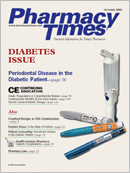Publication
Article
Pharmacy Times
CASE STUDIES
Author(s):
CASE ONE: BT, a 65-year-old woman, is brought by her daughter foran appointment with her primarycare physician. The daughter informsthe physician that the mother hasbeen confused, disoriented, andexhibiting memory loss.
Although BT has a history ofAlzheimer's-type dementia, she hadbeen stable on rivastigmine until afew months ago.
The physician explains to BT and her daughter that theyshould not be surprised by declines in BT's condition overtime. To be sure that the change in BT's condition is not dueto a precipitating reason, the physician gives her a fullexamination and reviews all of her medications. When thephysician looks at all of the prescription bottles that BT'sdaughter has brought with her, he notices that there is nobottle of rivastigmine. He asks if she has forgotten anotherbottle. She confirms that she has brought all of the bottles.
The physician is concerned that BT has not been takingthe rivastigmine. He calls the pharmacy to determine therefill history of BT's rivastigmine prescription. He learns thatshe has not filled it in 4 months.
He wants to restart her on rivastigmine. He tells the pharmacistto refill the rivastigmine and that the daughter will bepicking it shortly. Before hanging up, he remembers that hehad originally titrated BT's dose. Does he need to initiateher at a low dose again and titrate up?
CASE TWO: SA, a pharmacy student inhis final year of school, isspending a month at PRNPharmacy for his communityexperience rotation. AlthoughPRN Pharmacy also dispensesmanufactured medications, it isknown for its compoundedproducts. Because this is SA'sfirst day, he is a little nervous about compounding medicationsfor patients. The pharmacy manager reassures him thatall of his work will be double-checked by one of the pharmacists.For whatever work SA does, he should write down all ofhis calculations to assist in the double-checking process.
After SA compounds a liquid required to fill a prescription,he brings all of the ingredients to the pharmacist for verification.He explains that he made 500 mL of the solutionbecause the pharmacy received 2 prescriptions for the samemedication for twin sisters. Each twin needs to receive 250mL. According to SA's calculations, he mixed 62.5 g of medicationinto the liquid base.
According to the label and the hard copy of the prescription,the twins require a 1.25% solution of the medication. Isthe product formulated by SA appropriate?
Dr. Schlesselman is an assistant clinical professor at the University of Connecticut School of pharmacy.
Click Here For The Answer ----------->
[-]
CASE ONE: The physician should restart BT's rivastigmine at the lowest daily dose and titrate it. Despite having been onrivastigmine previously, BT has been off the drug for a few months, and therefore she needs to have the medicine titrated again. Four-week titrationintervals are recommended between dose increases. Higher doses are associated with increased incidence of side effects, particularly during dosetitration. If side effects occur during titration, dose reductions are recommended.
CASE TWO: The preparation made by SA actually is a 12.5% solution. The concentration of weight/volume dilutions are based on grams pereach 100 mL. Because the twins need a 1.25% solution, it should contain 1.25 g for each 100 mL. For 500 mL, he should have added 6.25 g,rather than 62.5 g.
toggle(getObject('exp1048685570_link'), 'exp1048685570');







